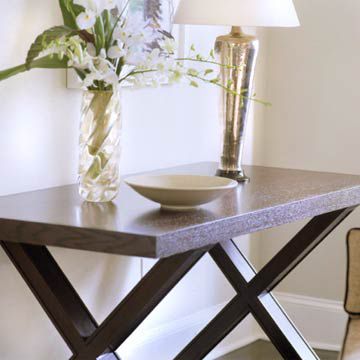Should you dust, clean, or wax your wood furniture? Read these suggestions followed by some tips from the experts.
Are you confused about dusting vs. cleaning, or waxing vs. polishing wood furniture?
While experts have varying opinions on the care of wood furniture, it usually depends on the finish of the piece.
Tip #1: Always ask for specific care and cleaning guidelines when purchasing new or old furnishings.P

Dusting
Don’t avoid dusting furniture. Frequent dusting removes airborne deposits that build up in a filmy layer and can scratch the surface.
Clean, dry, soft cloths or feather dusters will effectively remove dust; however, to avoid scattering the dust into the air, where it floats until landing back on furniture surfaces, dampen the cloth very slightly.
Never use all-purpose cleaning sprays unless your furniture has a plastic coating, such as the kind used on kitchen tables and children’s furniture.
You’ll usually want to avoid cleaning wood with water. However, sticky spots may need to be treated with soap and water.
Here’s how: dip the cloth in mild soap or detergent dissolved in water, wring the cloth nearly dry, and wipe the area. Rinse and immediately dry with a clean, soft cloth.
Oil polishes, cleaners, and furniture oils protect wood by making the surface more slippery; they do not offer a hard protective layer.
Products that contain a high percentage of oil make the surface smear, showing fingerprints. Avoid polishing with pure olive oil, which smears and attracts dust.
Most commercial spray and liquid furniture polishes contain silicone oil, which provides some protection. If you have used sprays and polishes in the past or suspect that furniture has been polished with them, be aware that residues can interfere with refinishing and may need professional attention.
Homemade recipe for cleaning wood: Some experts recommend reviving grimy wood furniture with a mixture of equal parts olive oil, denatured alcohol, gum turpentine, and strained lemon juice. Apply with a soft cloth and buff with a clean cloth.
Typically during manufacture, varnish, polyurethane, or shellac is applied to wood to protect the surface. Applying wax or polish protects the manufacturer’s finish and helps to reduce surface scratches.
Wax provides a hard finish and long-lasting protection, doesn’t smear, and is more durable than sprays or polishes.
Use paste wax or liquid wax made specifically for furniture. Depending on use, paste wax finishes may last as long as two years. Liquid wax is easier to apply but leaves a thinner coating; it may need to be applied more frequently than paste wax.
Learn how to properly apply waxes to eliminate streaks or a cloudy appearance. Always apply wax in light coats, rubbing into the surface with the grain. Allow to dry and buff to a clear shine with a soft cloth.
Tips for Applying Paste Wax to Barstools & Dinettes
Rub in a circular motion, one small area at a time, until the waxing is complete. When the surface dulls, wipe off the excess wax. Use a clean, soft cotton cloth and turn it frequently. Repeat waxing and wiping until the entire piece is waxed. If you notice a streak, keep wiping to remove excess wax. Polish the wood, with a soft cloth or lamb’s-wool pad attached to an electric drill or power buffer. If the wax smears, wipe with a soft cloth and continue buffing.For a deep shine, apply a second coat of wax in the same manner; to maintain waxed furniture, dust with a lamb’s-wool duster.
 Never use liquid or aerosol furniture polishes because they can dissolve the wax and leave a hazy film.
For fine furniture or treasured family heirlooms, use this three-step cleaning and care routine.
1. Clean approximately every year with a commercial cleaning product (such as Formby’s Deep Cleaning Build-Up Remover) using #0000 steel wool. Work with the grain and follow product directions carefully.
2. Restore as needed, especially from sun fading, using a commercial finish restoring product such as Howard Restor-A-Finish. Choose a shade closest to the wood stain and apply with #0000 steel wool to a small section at a time. Work with the grain of the wood and use light to moderate pressure. Immediately wipe with a soft, lint-free cloth, such as cheesecloth.
3. Feed as a monthly routine using an orange oil or wax (try Feed-N-Wax beeswax) to prevent drying and cracking.
Okay, so you’ve found that perfect piece at a garage or tag sale! Now, how can you bring out its best?
Deep Cleaning Barstools & Dinettes
As a first step to removing layers of grime, use an oil soap and water. Rinse and dry well. If the finish still seems dirty, clean lightly with #0000 steel wool dipped in a cleaning product. Some products with a milky appearance are formulated to dissolve both solvent-based and oil-based residues. Do not use mixtures containing boiled linseed oil, turpentine, or white vinegars. Museum conservators say these things darken wood and attract dust and lint. Instead, apply clear paste wax.
Polishing Hardware for Barstools & Dinettes
Remove hardware from the furniture piece. Clean with a metal or brass cleaner and buff. Reattach when completely dry.
Scratching the Surface on Barstools & Dinettes
If the top of wood furniture is slightly scratched, apply paste wax or use a felt-tip touch-up pen.
To treat deeper scratches that gouge into the wood, use wood filler or a colored filler wax stick available at hardware and home improvement stores. Match as closely as possible to the color of your piece, applying in several thin layers rather than in one thick layer.








